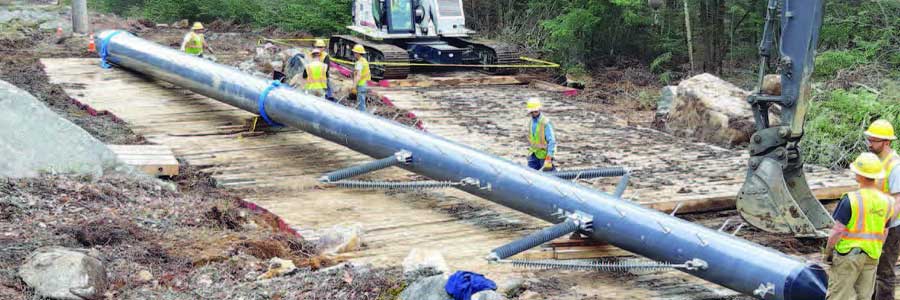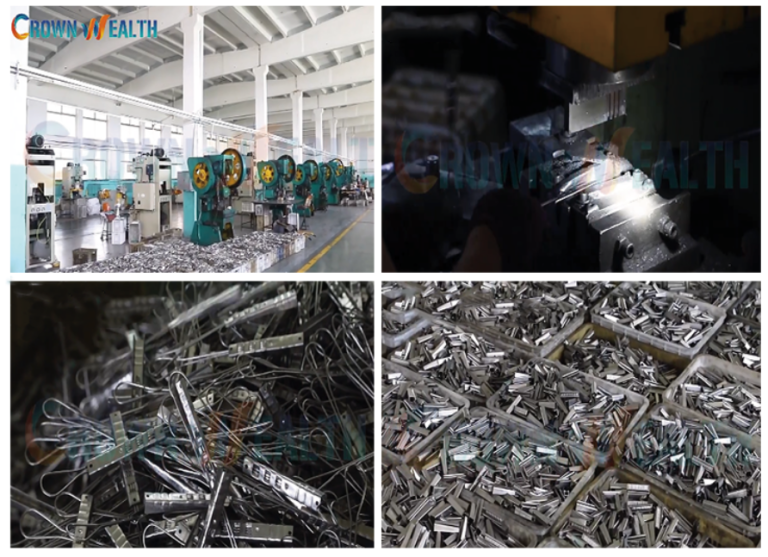Utility poles are an indispensable and important support for overhead power transmission line infrastructure such as long-distance communication and power transmission. They carry communication cables, power transmission, telephone lines and other public service facilities and electrical equipment for our daily use. To ensure the stability and reliability of overhead power transmission lines, you also need to understand different types of utility poles. In this article, we will give a detailed introduction to utility poles from the perspectives of material selection, project facility application and other aspects, hoping to help your power transmission line project application.
Table of Contents
ToggleCommon Types of Utility Poles
Choosing the most appropriate utility pole material is an important decision to ensure the longevity, safety and environmental footprint of the utility. The following is a brief description of the advantages and disadvantages of different types of utility poles:
Wooden Utility Poles
For more than a century since the discovery of utility poles, wooden utility poles have always been the first choice of material because they are low cost, easy to install and have certain insulation properties. Most of these wooden poles are made of high-hardness and durable wood such as pine, cedar and fir. To prevent corrosion by woodpeckers, insects and nature, relevant manufacturers now use new environmentally friendly preservatives such as pentachlorophenol and copper zinc arsenate to replace the ancient creosote.
Although the average life of dried wooden utility poles can reach 25-50 years, the reason why the utility poles collapse is often because of the part buried underground. The voltage capacity of wooden utility poles is limited, and the risk of fire is very serious under extreme high temperature or short circuit conditions, so we have to pay a relatively high cost to check and maintain them regularly.
It is recommended that distribution poles and telephone poles should be made of wooden materials first.
Steel Utility Poles
Steel utility poles can also be divided into stepped poles and swaged poles. The former has built-in maintenance steps and is used as road sign poles, while the latter is a pole that has been specially shaped to increase its strength.
The emergence of steel utility poles has given people another choice. Its higher strength, durability and lower maintenance costs are favored by people. Steel can be remelted and formed without reducing its strength, so it has more recycling value than wooden poles.
Steel utility poles are extremely flexible in height. We can manufacture higher poles to accommodate safer load voltages. Kindly note that as the height of the pole increases, more guy wire may be needed to support the steel pole, which will increase the cost.
Our steel utility poles are forged from high-quality carbon steel. The surface is evenly galvanized and is not easy to rust. The average service life can reach 60 years, and 80 years of use with proper maintenance is also possible.
Although steel poles have many advantages, they still have disadvantages. Galvanized steel metal poles are used for overhead line power transmission, and more safety insulation precautions need to be taken to ensure the stability and safety of the transmission line. Another is that the initial investment cost will be higher than wooden poles, but the service life is longer and the maintenance cost is relatively low.
Concrete Utility Poles
Concrete utility poles can withstand the test of any harsh environment. The strength and corrosion resistance of reinforced concrete are unquestionable, and they can naturally resist the corrosion of nature and the destructive power of wild animals. They are often used in coastal areas, flood-prone areas, and areas where wildfires often occur.
The only limitations of concrete utility poles is that they are “heavy”. If they are not made on site, the transportation cost will be very high, and installation will often be a problem for people. Another is that concrete utility poles are difficult to transform and have poor flexibility. As the years increase, once their strength decreases, it will become a new source of danger.
Fiberglass Utility Poles
These fiberglass utility poles are molded under a special process of extreme heat and pressure using new resin and fiber composite materials and manufactured under strict control and quality guidelines. They are known for their high strength, strong wind resistance and fire resistance.
Fiberglass utility poles are hollow, they weigh 20% of steel and 40% of treated wood, much lighter than wood, steel and concrete poles, easy to handle and install. But it’s strong and durable, and can achieve the same structural strength as Class 2 wood poles.
Composite utility poles can be customized in various shapes and sizes according to your specific design requirements and aesthetic preferences, ensuring seamless integration into your overhead lines. This makes it an ideal choice for upgrading or installing new transmission infrastructure. The fiberglass utility pole cost and its service life are your main reference criteria.
Ductile Iron Utility Poles
Ductile iron is a special metal known for its strength, durability and resistance to corrosion, wear and fatigue. Utility pole suppliers originally designed them for a longer-lasting and more stable pole, however, the average service life of a ductile iron pole can exceed 75 years. The downside is that the initial investment is sometimes higher than other materials, but the low maintenance requirements and long service life of ductile iron can save money, making it an economical and efficient choice for you.
Ductile iron is much lighter than concrete, making it easier to transport and install, further improving efficiency. With the increasing cost of wood poles and the longer service life of ductile iron, Hbcrownwealth is currently considering using these poles on some future projects.
What is on a Utility Pole?
As one of the leading utility pole manufacturers in China, we can also provide you with a one-stop solution for pole line hardware. The power line accessories we produce meet American standards and are often applied to utility poles by local dealers or power telecommunications operators. Next, let’s take a look at what’s on the utility poles:
Traditionally, what do you subconsciously think is on the telephone pole? Nothing more than wires and cables. In fact, not entirely. In addition, there are many different types of hardware accessories on the utility poles that accompany and support the daily work of these wires and cables. In today’s society with developed power and telecommunications, there may be some fiber optic terminal boxes and transformer facilities and equipment located on the utility poles.
So Hbcrownwealth, as one of the trusted utility pole hardware suppliers, what accessories do we produce that will appear on the utility poles? Wow, there are too many, such as: Electrical Cross Arms, Drop Wire Clamps, Anchoring Clamps, Guy Grips, Span Clamps, Hooks, Bolts and Nuts, Guy Clamps, Guy Wires, Banding Bracket, Pole Band, etc.
Go to View All Products →
These utility pole and pole line hardware have many important uses, not limited to the following features:
◇ Provide structural and safety support for the pole
◇ Assist in the conversion and transmission of power and telecommunications lines
◇ Convenience of wire pulling and wiring requirements
Conclusion
If you want to choose the right power pole material, you need to consider durability, cost-effectiveness, environmental responsibility and local suitability. We wrote this article based on questions from our customers every day and by considering the pole materials of existing partners in local application markets to ensure that the poles installed on the ground for overhead transmission lines will continue to serve the best interests of the community, the environment and the industry for many years to come. If you have additional questions, please contact us today to learn more.
FAQ
What is a Utility Pole?
A utility pole is an upright post used to support long-distance overhead lines and utility service equipment.
What are Utility Poles Made of?
Utility poles can be made of wood, ductile iron, galvanized steel, concrete or composite materials such as fiberglass. They are used for different types of transmission lines, secondary transmission lines that carry high-voltage electricity between substations, and distribution lines that distribute low-voltage electricity to customers.
How do Power Poles Work?
Power poles, also known as utility poles, are key components in the distribution of electricity and telecommunications services.
◇ Structural support
◇ Transmission distribution
◇ Insulation safety
◇ Supporting equipment
◇ Grounding to protect the system from electrical surges
Where to Buy Utility Poles?
When looking to buy utility poles, there are several options depending on your location, the type of utility pole you need, and whether you’re purchasing in bulk or for a specific project.
If you are a dealer or need to buy utility poles in large quantities, it is recommended that you choose utility pole manufacturers for purchase, because their quality and factory price are the best. Hbcrownwealth is one of the most reliable manufacturers and suppliers in China, contact us immediately to get the most competitive market price.
If you use temporary transmission line support poles, you can choose to buy from local utility supply stores or online retailers and marketplaces, they are best for retail.
How Deep are Telephone Poles in the Ground?
The typical depth of wooden, steel and fiberglass utility poles buried in the ground in general environments is about 6 to 8 feet (1.8 to 2.4 meters). Concrete utility poles need to be buried deeper because of their own materials, about 10 to 12 feet (3 to 3.7 meters).
For safety reasons, the burial depth of utility poles must take into account the local environment, materials, height, location and local regulations and design specifications to implement the specific installation of utility poles.
How Much Do Telephone Poles Weigh?
Utility poles are usually made of wood, concrete, steel, and fiberglass. Each material has a different density, so their weight is also different. We can refer to the density of each material for a simple estimate.
- – Wood are about 650 kg/m³
- – Concrete are about 2400 kg/m³
- – Steel are about 7850 kg/m³
- – Fiberglass are about 1800 kg/m³
Take a 40 feet utility pole as an example:
- Wood utility pole 545 kg
- Concrete utility pole 900 to 1100 kg
- Steel utility pole 225 to 450 kg
- Fiberglass utility pole 90 to 136 kg
How to Install a Utility Pole?
Transportation: If not made at the location the pole needs to be brought on-site
Digging the Hole: A minimum depth of 1/3 of the pole length for maximum stability
Grounding: The pole needs to be grounded with copper to drain excess voltage
Positioning: The pole needs to be correctly positioned and then lifted
Insertion: Once optimal, the pole can then be eased into the hole
Securing: The hole is filled and leveled, securing the pole in place



























